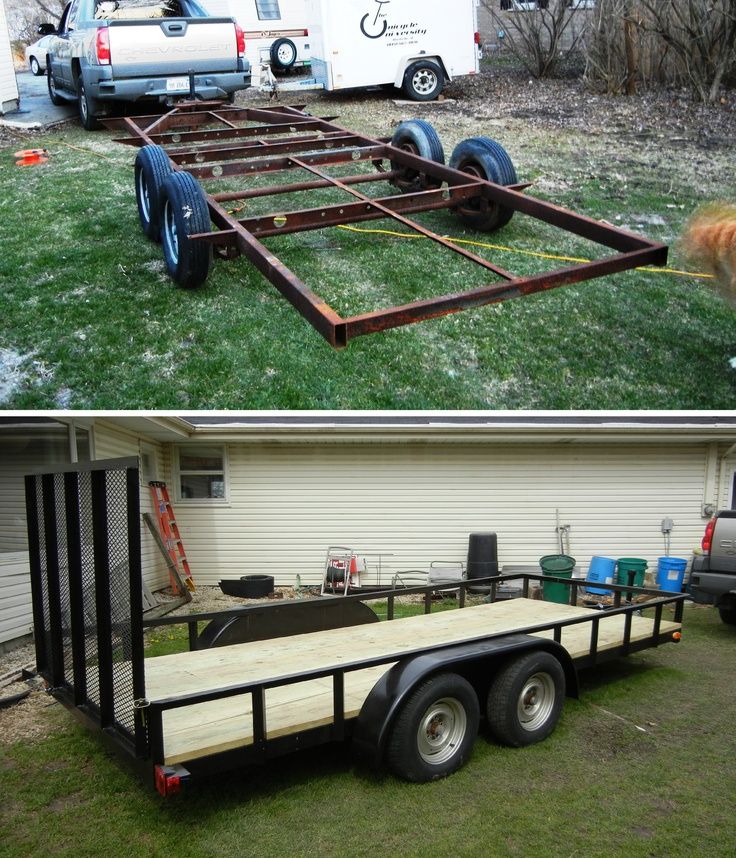All-terrain vehicles improve access to the backcountry. ATVs and side-by-sides excel at carrying people, but their restricted cargo room limits the gear we can haul in, and the meat we can pack out. To better suit my outdoor adventures and projects around my homestead, I needed more space to haul the necessary gear. It was time to build a utility trailer!
Advertisement
In the spirit of any good DIY project, salvaged materials kept my costs down. I used as much repurposed metal as possible to create my ATV trailer. When using old metal, good prep improves weld quality, so I brushed or ground off rust and old paint.
Advertisement
I rate this project as intermediate both for its required skill level and time to complete. To tackle this project, you’ll need access to a welder and a compliment of workshop tools. I chose wood planks for the decking, so a method to cut wood to length helps too. I’m not a welder by training, so there was a steep learning curve.
Nevertheless, using a MIG welder and attention to detail, I achieved ‘professional’ results.
The hardest part of the project was coming up with a design. Plan considerations included trailer purpose, bed size, ground clearance, tires, hitch, load capacity and overall trailer weight. Some of decisions were easy, based on locally available materials – type of hitch, for example. Others crystalized after much deliberation. With my trailer specs and materials in hand, it was time to start cutting.
Advertisement
I cut the metal parts with a chop saw, a bandsaw and a special thin cutting blade on an angle grinder – any of the three will work well. The three-foot by five-foot frame was built using one-and-a-half-inch square tubing, which is strong and makes a superb platform on which to mount everything else. Simple butt joints to make neat square corners simplified welding for a beginner. Using two-inch square tubing for extra strength, I welded the tongue at 26 inches, allowing ample clearance between the ATV and trailer, even during tight turns.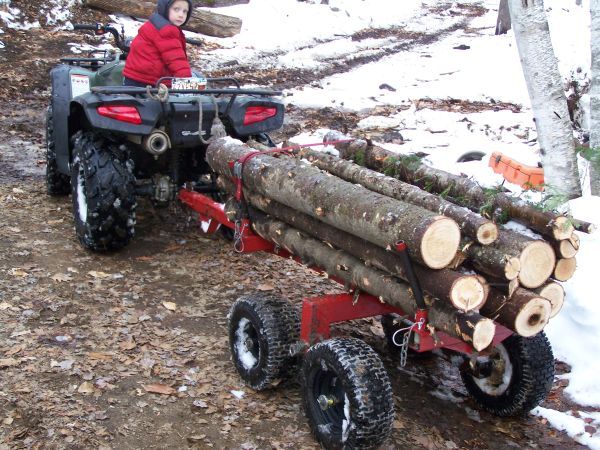 For frame strength and a place to secure the decking, I welded angle iron side to side across the trailer in strategic locations.
For frame strength and a place to secure the decking, I welded angle iron side to side across the trailer in strategic locations.
The wheel assembly is the most complicated part of this project. An online search returns several suitable ideas, from a simple straight axle with no suspension, to more complex walking axle designs. For me, design considerations included the type of tire. I opted for a standard 14-inch trailer tire and reduced the fabrication process by purchasing a pair of bolt-on equalizer torsion axles for a five-bolt rim. Swapping tire hubs to a four-bolt ATV style will accommodate off-road ATV-style floatation tires. I fabricated the axle supports using angle iron. Using the wheel assembly as a template, I marked and drilled holes to accommodate the bolts.
I used a wire wheel on an angle grinder to clean and rough up the metal surface of the trailer prior to painting. For paint, a rattle-can of spray paint for metal did the trick. To prevent slipping when wet, I plan to add a rubberized rocker guard paint on the tongue.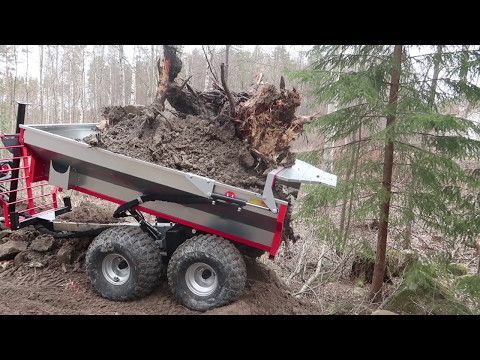
With the trailer still upside down, I bolted the axle assemblies to the frame and installed the tires. My wife and I easily lifted the trailer off the sawhorses and rotated it to sit on the ground right-side up. It wasn’t too heavy, yet!
Next was cutting the trailer decking – I used spruce 2x6s and 2x8s – securing them to the trailer using self-tapping metal screws into the angle iron supports. For longer life, I’ll paint the deck with a water seal. Treated lumber works well too, I just didn’t have any on hand at the time.
After the trailer frame and deck was built, it was time to focus on the sides. For now, I just needed a cart to haul logs and game out of the field, so I added arms that flare out from the trailer for more capacity. An alternative is quick-detach brackets and modular sides to slide in, to suit your adventure.
The last step was installing a trailer coupler. I used a standard part-store aluminum ball-hitch coupler, simply bolting the basic coupler through the tongue.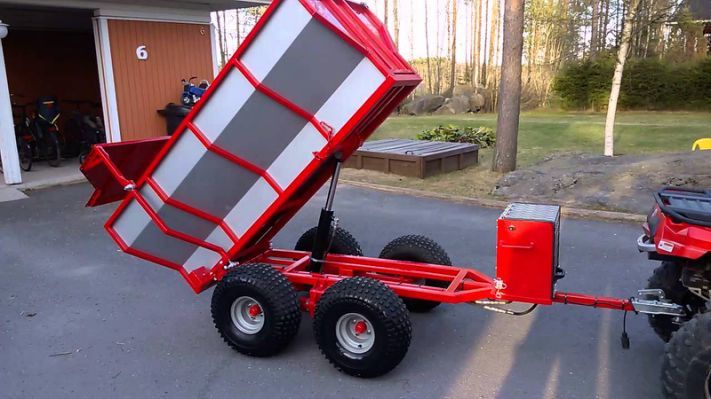 I admit, I do admire the swivel hitch designs for safety considerations in rough terrain – if you misjudge your centre of gravity, your cart can tip without flipping the ATV on its side as well.
I admit, I do admire the swivel hitch designs for safety considerations in rough terrain – if you misjudge your centre of gravity, your cart can tip without flipping the ATV on its side as well.
I had a great deal of fun researching and building this project. I learned new skills and created something that makes me proud to look at and use. Plus, I now have a custom trailer that is more solid and heavy-duty than most commercially made items of this size. If I wished to get it inspected and licenced, I could use it on the road behind my truck as well.
Have fun choosing your options and building your own utility trailer!
Step 1, plans and parts: I decided on the size, shape and parts specification for the trailer I wanted to build. I scrounged used metal where I could and purchased the parts and materials I needed.
Step 2, layout: Metal parts measured and marked in preparation for cutting.
Step 3, cutting: I used a chop saw to cut most of the metal parts to length.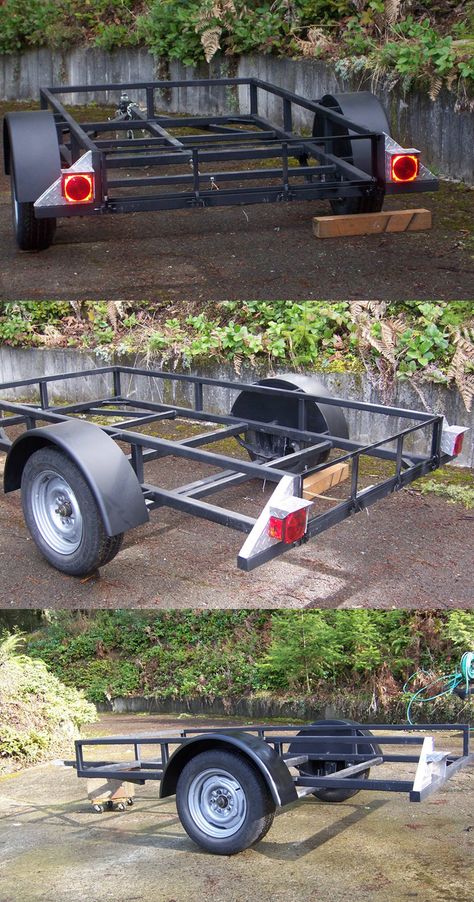 A metal cutting bandsaw is another method for cutting metal parts.
A metal cutting bandsaw is another method for cutting metal parts.
Step 4, metal preparation: Good metal preparation is crucial to good welds, especially when using recycled metal. Here, a wire brush on an angle grinder removes old paint and rust.
Step 5, welding: Magnetic clamps hold the workpiece while welding, keeping everything square. For the perfect fit, the axle assemblies were used as a spacer while the supports were tack-welded into place.
Step 6, painting: After welding the frame, the steel was painted before assembling.
Step 7A, assembly: The axel assemblies were bolted onto the frame supports, followed by tire installation.
Step 7B, assembly: The hitch coupler was bolted to the tongue to facilitate future upgrades or replacement.
Step 8, final details: Install side arms and pre-cut decking.
The final product, showing clearance, axel assembly and tires.
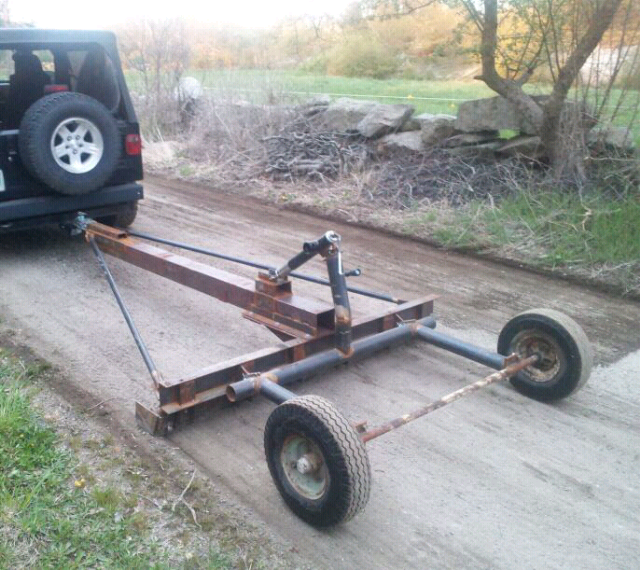
Our smallest ATV and off road vehicle specific trailer plans. Great for taking 2 ATV’s out, yet small enough for towing without a big truck. The size also makes for easier storage between the fun trips.
$ 19.99 - Complete Plans
* Plans are in a computer document. You may Save them to your computer immediately after Payment.
ATV trailer plans specifically designed for 2 ATV’s with the ramps needed to easily load and unload. Plans include several variations for customization like ramps that attach to the side for loading, and store under the trailer for traveling. This trailer has been engineered for strength, for functionality, and on-the-road stability! Check out all the features.
We offer two sizes of ATV trailers — Both versions accommodate 2 full size ATV’s.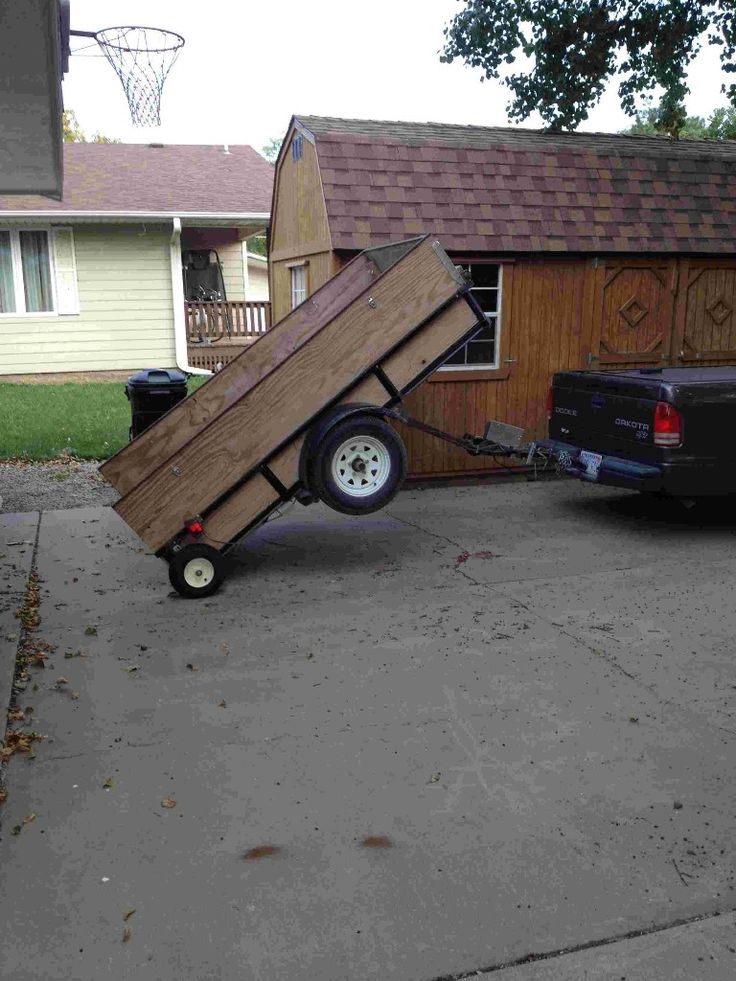 This is the smaller size (5’x 10.5′ bed), so it’s a little narrower and shorter but holds 2 ATV’s just the same. The narrower profile can be a benefit when towing with something other than a full size vehicle. The larger size (6’x 11′ bed) has a wider deck for a little extra bed space to carrying your extra gear. Both are designed for a single 3500# axle, and both come with lots of options for customizing the trailer to your needs.
This is the smaller size (5’x 10.5′ bed), so it’s a little narrower and shorter but holds 2 ATV’s just the same. The narrower profile can be a benefit when towing with something other than a full size vehicle. The larger size (6’x 11′ bed) has a wider deck for a little extra bed space to carrying your extra gear. Both are designed for a single 3500# axle, and both come with lots of options for customizing the trailer to your needs.
Note: Actual bed is slightly bigger than the stated size in feet.
Add To Cart
5′ x 10.5′ – 2 Place ATV Trailer Plans
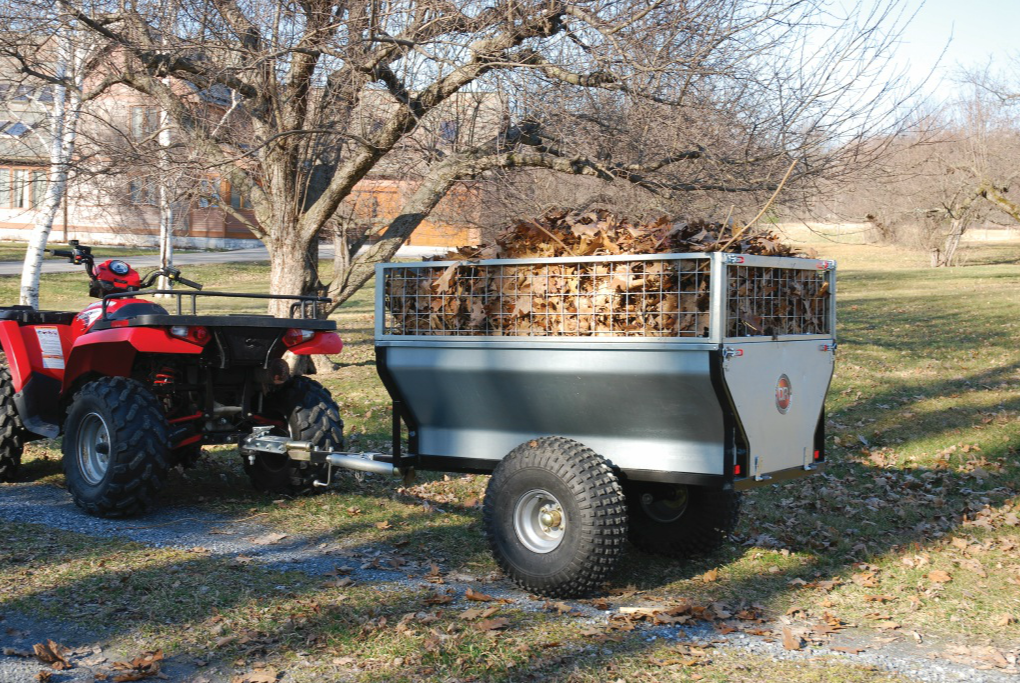
Add To Cart
Plans from Mechanical Elements are an awesome start to a great project. Here are even more resources!
First: For more info, please read: What's In The Plans? and What Makes Our Trailer Plans Better?
Second: Purchase plans with the "Add to Cart" button, then right after payment, a digital copy is ready to save to your computer. Please see this article for answers about getting the plans.
Third: We have many articles to help with trailer building. Just type a question in the Show Me bar (top of this page), then press "GO". Or, for simple browsing, visit Articles from the Mechanic.
Reminder:
Trailer building requires metal working skill and tools for things like cutting, drilling, and accurate set-up, as well as welding skill. Strength, durability, and enjoyment depend on building the trailer well.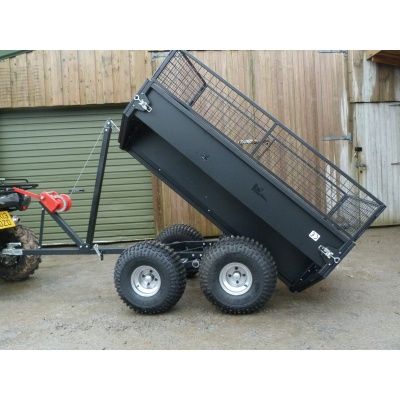 Build it well, then Enjoy the Finished Project !!
Build it well, then Enjoy the Finished Project !!
* Trailer load capacity depends on all the parts and materials, as well as the craftsmanship in building. All Mechanical Elements trailers are engineered to perform as stated when built as defined with proper care in construction – including parts, material, construction techniques, weld integrity, assembly methods, and finishing. Capacity for this trailer also requires proper choices for parts such as the hitch, axle(s), wheels, tires, safety chain, decking, bolts, pins, etc. Please make sure component load capacities match or exceed the trailer total capacity. Do not exceed manufacturers limits.
For trouble-free trailer life, think care and safety. Please select fastening methods to handle how and where the trailer will operate – including vibration, proper fastener types, bolt grades, torques, and nut types (like lock nuts). Then, be smart about loading the trailer, load distribution, tire pressure, tire condition and the mechanics of towing.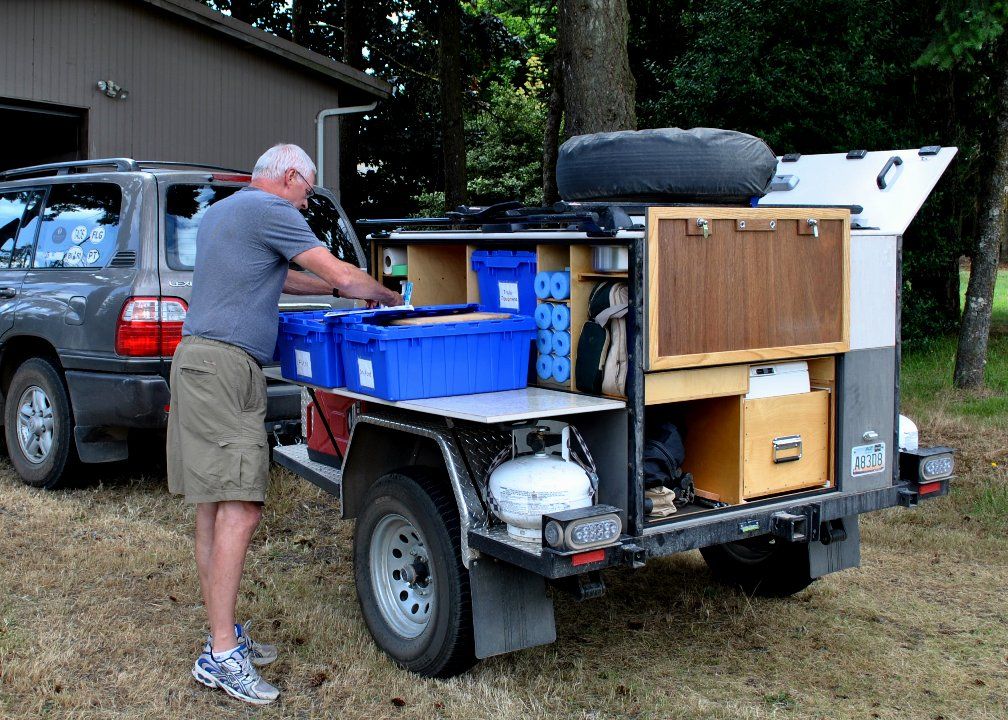 We want you safe to enjoy your trailer for a long time ahead. Always use proper safety and securing equipment when loading and towing a trailer.
We want you safe to enjoy your trailer for a long time ahead. Always use proper safety and securing equipment when loading and towing a trailer.
Thank You — The Mechanical Elements Team
Article
Often misused and not very well understood — so goes the life of many metalworking files. Yet, they still do things other tools can’t. That makes them a tool worth knowing!
Read The Article
Article
Over and over we recommend: “Don’t use torsion axles in tandem because they don’t load-share”. Well, What if we make them share? Here’s a new design that brings the benefits of a torsion axle to the tandem axle party
Read The Article
Product
Article
Don’t mess around with your safety or unexpected trip interruptions.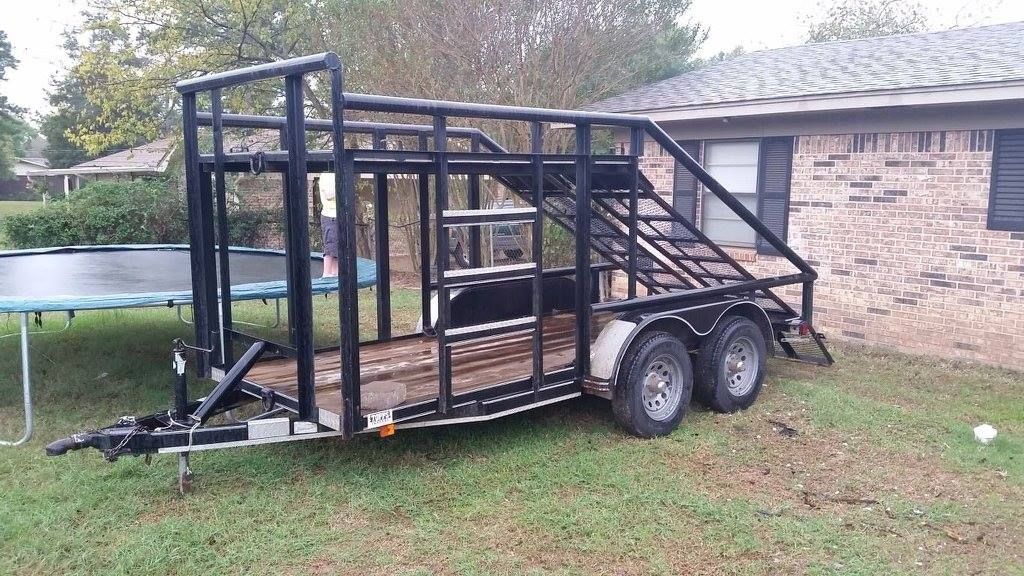 The Best Reason to replace old or worn trailer tires is personal sanity, because who wants to deal with it on the side of the road?
The Best Reason to replace old or worn trailer tires is personal sanity, because who wants to deal with it on the side of the road?
Read The Article
Product
Article
Do you want a new Utility Trailer? Or, an OHV Hauler? We have plans for those, but the big question is: When should you build your new trailer? versus When should you just go out and buy one?
Read The Article
Article
When is an I-Beam not really an “I” Beam? While it’s common to use the generic term “I-Beam” for any beam with an I shape section, there are actually variations with different letter designations. And, there are advantages for the…
Read The Article
Article
Is there anything more annoying (painful and frustrating) than busting a knuckle when working on things in the shop? To many of us, blood sacrifices are just part of getting a project done, but it doesn’t have to be that…
Read The Article
Article
As a convenient way to help with safety, trailer hitches, balls, and receivers have categories or load rating groups called classes. Each trailer hitch class has ratings for how much it will carry. A look at the ratings for each…
Each trailer hitch class has ratings for how much it will carry. A look at the ratings for each…
Read The Article
Product
Construction parts are available from a specialized automotive or other parts store. It is better to buy consumables separately, rather than using old spare parts from a trailer or walk-behind tractor that was previously used on the farm. In the photo above, you can see drawings of an ATV trailer and present a functional assembly diagram of the structure.
Making your own ATV trailer at home starts with the axle, the main part of the trailer.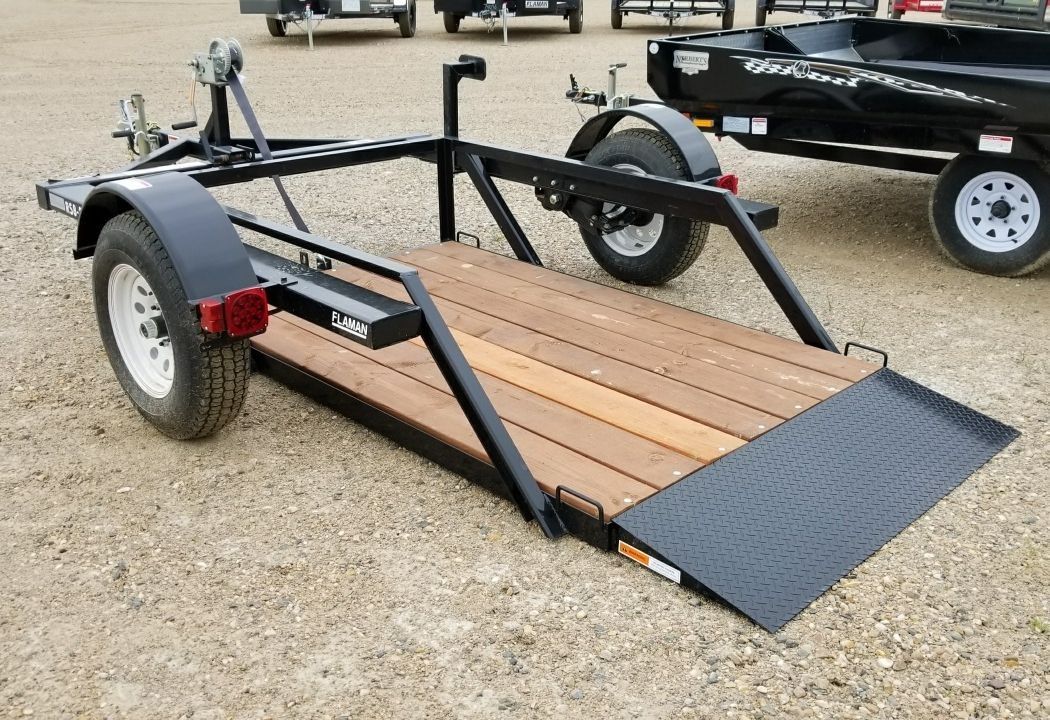 It is purchased in a service where parts are sold in two variations: assembled or collapsible. It is better to take a model with suspension and maintenance-free hubs of the most common "classic" wheels. They differ in width up to 170 cm. In the case of constructing a trailer for an ATV with your own hands, you will need only 120 cm of the axle, so you will have to file the part. But this is not a problem compared to the need to dismember the trailer from the car in order to narrow it down.
It is purchased in a service where parts are sold in two variations: assembled or collapsible. It is better to take a model with suspension and maintenance-free hubs of the most common "classic" wheels. They differ in width up to 170 cm. In the case of constructing a trailer for an ATV with your own hands, you will need only 120 cm of the axle, so you will have to file the part. But this is not a problem compared to the need to dismember the trailer from the car in order to narrow it down.
So, armed with a grinder, you managed to saw the axle. Technically, it is necessary to remove a small piece from the middle part of the part so that when the two parts of the axle are joined and the wheels are mounted, the total length is no more than 120 cm.
Leaving the first stage behind, proceed to the docking of the axle halves. A pipe with a diameter slightly larger than the axis itself is selected so that the ends of the part are placed inside with almost zero clearance.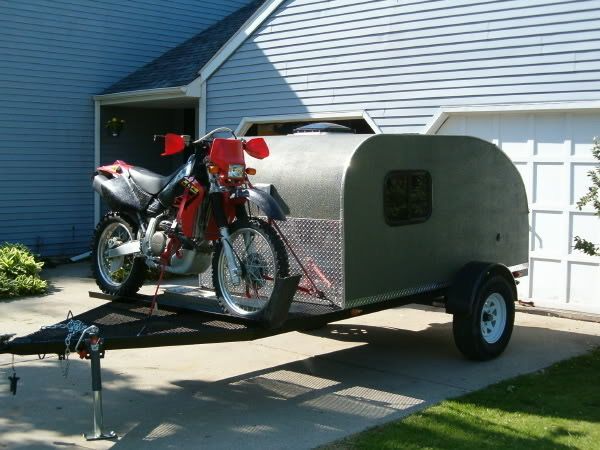 Having installed all the details in their places, the pipe, together with the halves inserted inside it and fixed, is boiled in a circle, ensuring a secure fastening. The first stage of designing an axle for an ATV trailer with our own hands has been successfully completed.
Having installed all the details in their places, the pipe, together with the halves inserted inside it and fixed, is boiled in a circle, ensuring a secure fastening. The first stage of designing an axle for an ATV trailer with our own hands has been successfully completed.
Next, proceed to the manufacture of the drawbar. If you don't know what it is, we'll explain. The drawbar is what pulls the trailer. Steel rectangular profiles can be used as a material for production. The size of this structural element is determined taking into account the expected load on the ATV trailer.
Select the length by calculating the length of the load: the longer the load, the longer the drawbar. Although, as a rule, this is an arbitrary indicator. The center of gravity is on the axle. The fastening is reinforced by welding small plates of arbitrary shape.
The dimensions of the ATV trailer are arbitrary. Now we have to decide on the length of the site of the future homemade trailer.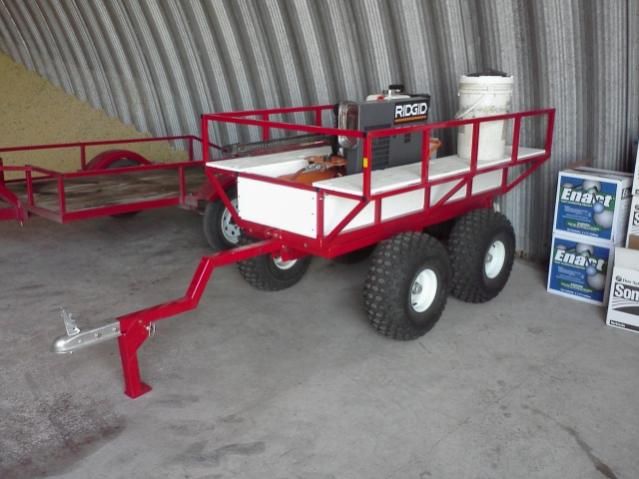 Since the owner constructs everything with his own hands, he can afford to choose the size himself, based on his needs. But do not forget that the trailer must be convenient for transportation and approximately the size of an ATV, otherwise it will not be maneuverable.
Since the owner constructs everything with his own hands, he can afford to choose the size himself, based on his needs. But do not forget that the trailer must be convenient for transportation and approximately the size of an ATV, otherwise it will not be maneuverable.
In pursuit of convenience and speed of docking, take a tow ball and a self-locking hitch ball. The ball is welded at the back, attaching it to the beam. The other part is bolted to the drawbar. If necessary, shorten the length of the bolts.
The frame must be suitable for the trailer's function. Steel profiles are cut to the required length and welded. For sheathing use metal or thick plywood. Fastening to the frame is done with countersunk bolts or rivets. The surface is coated with an anti-corrosion compound in order to extend the life of the trailer.
So, after doing a little work, you will have a homemade trailer on your farm. Get such a technique, try to construct it yourself and make sure that it is simple and profitable.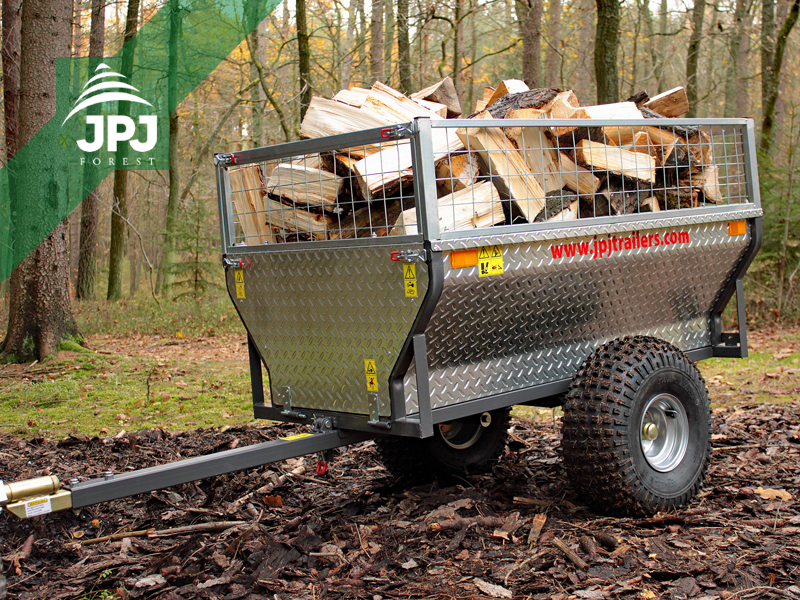
To buy an ATV for a child or an adult means to get a device that is highly reliable, has excellent cross-country ability, and is also unpretentious to operating conditions. A trailer will help to significantly expand the functionality of this type of motorized equipment, which can either be purchased at a specialized store or made by hand. Many models of ATVs are capable of transporting even loads weighing a ton, and therefore a homemade trailer will be extremely useful in the household.
An ATV trailer is an auxiliary vehicle that is not equipped with an engine, and therefore can only be moved together with a motorbike. To connect motorcycles to a trailer, special fastening devices are used, for example, a hook-and-loop.
Please note that there are significant differences in driving an ATV with and without a trailer, namely:
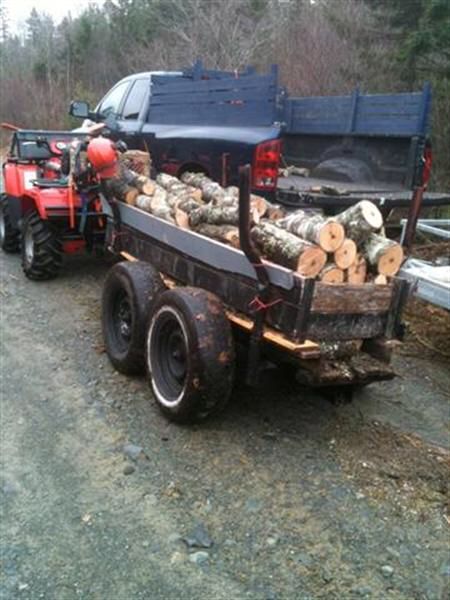
When it comes to trailer maintenance, special attention must be paid to the coupling point. It is this that is subject to the most wear and tear.
The desire to build a self-made trailer for an ATV usually arises from a motorist for the following reasons:
On the net you can find ready-made diagrams, drawings and manuals on how to make a trailer for an ATV with your own hands. Therefore, you have the right to choose absolutely any option in accordance with your own preferences and budget. Do not forget to take all the necessary measurements from the ATV, if they are not indicated in the motorbike passport.
The assembly of such a transport facility consists of the following steps:
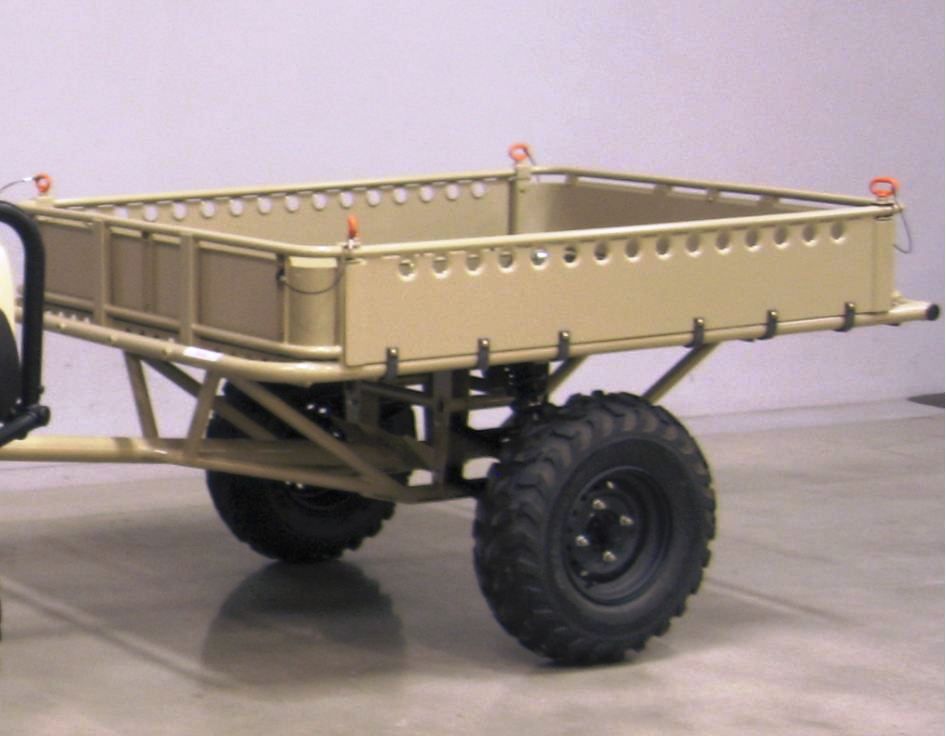 You can purchase both a new part in a specialized car shop, and a used one on the bulletin board;
You can purchase both a new part in a specialized car shop, and a used one on the bulletin board; In order for the trailer to be easy to use and not greatly reduce the maneuverability of the vehicle, their dimensions must match. Before starting work, thoroughly consider the design of the structure. At the final stage of creating an ATV trailer with your own hands, be sure to cover the surface of the product with an anti-corrosion coating, due to this it will be possible to significantly extend its service life.
Trailer wheels can be chosen by the owner at his own discretion, unless it is necessary to make sure that they fit the type of axle being used.